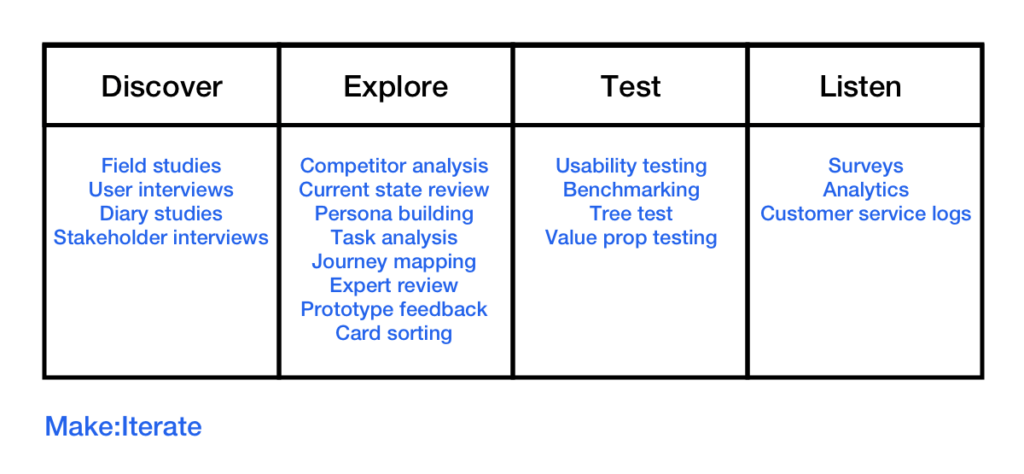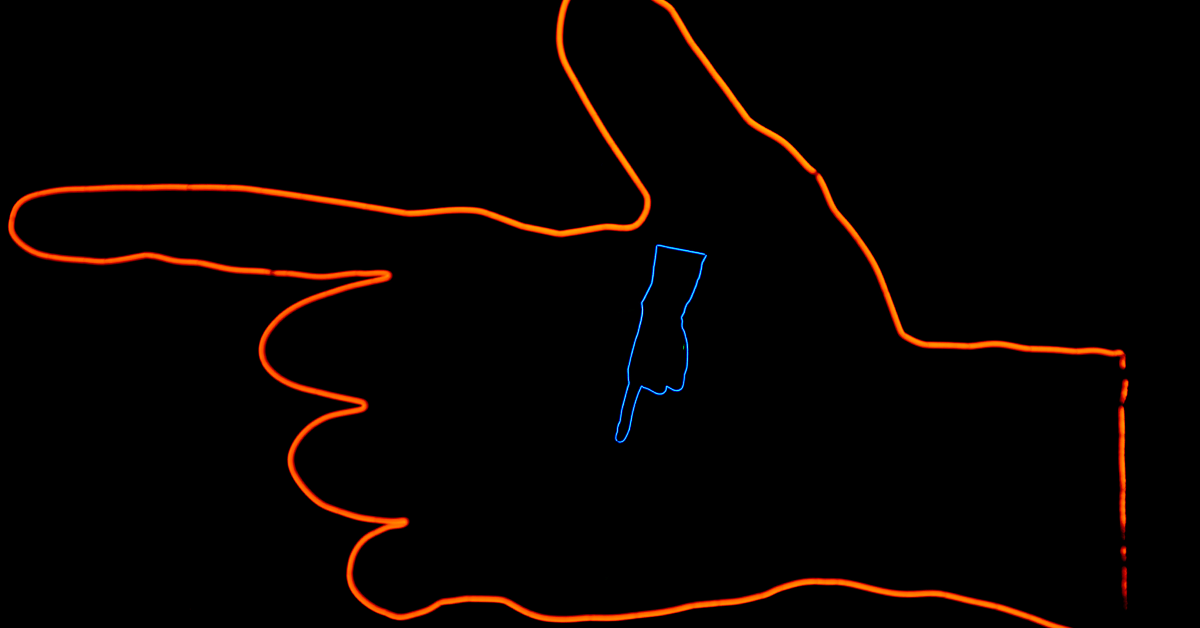You have no way of knowing what will resonate with your audience if you don’t conduct user research.
Proper user research can decrease the risk of wasting time, money, and resources.
It’s also the surest way to design products and services that people love.
In this article, we’ll give an overview of UX Research basics to help you get the insights you need to have a meaningful impact on your customer’s lives.
Understanding Your Users: Why User Research Is Critical to Product Success
Building a product, without conducting user research, would be like designing a house, without ever speaking to the people who’ll call it home.
You’ll know from personal experience what houses are like. And you know what you’d look for in a home. You’d like a simple, 3-bed, modern, open-plan home, with a garden that’s easy to maintain.
Building a product, without conducting user research, would be like designing a house, without ever speaking to the people who’ll call it home.
But…
The family you’re designing for could be a large family, with lots of kids and an elderly grandparent who struggles with stairs. They might want an old characterful home with a wild garden that needs taming.
The fact is, without conducting proper research, you have no way of knowing who your audience is, and what will resonate with them.
You’re chained by your own preferences, biases, and beliefs, based on your own personal experiences, which are almost certainly very different from the people you’re designing for. Even if you think they aren’t.
UX Research saves us time, money, and effort in the long run.
It provides us with evidence to help us decide what to design.
It provides us with insights to help us decide how to design it.
It helps us validate that we’ve made good UX Design decisions.
User research is critical to success and should be a central part of any digital product development process. We can adapt our approach depending on how much time, budget, and resources we have. But even if we have very little, we should always try to conduct some user research.
Finding the Right Moment: When to Conduct User Research
User research isn’t something that occurs just once.
It’s an ongoing process, taking place at every stage of the development cycle.
It can help us to understand our users’ needs and goals before we start designing.
User research is an ongoing process, useful at every stage of the design journey.
It can help us evaluate our designs as they evolve, making sure they meet the needs of our users.
And, it can be used after launch to help us track performance and gather insights for the future.
There’s always something that can be learned from user research, at any stage of development.
Research Methods: Choosing the Right Tool for Each Stage of Design
In simple terms, there are different research methods that are appropriate for different stages of development.
But ultimately, the UX research method you choose will depend on what you want to learn.
There are different research methods for exploring and evaluating designs, depending on what you want to learn.
Some techniques are generative, they’re great for exploration and discovering new insights. While other techniques are evaluative, they help us to evaluate our designs and validate our decisions.
Here are the 3 most popular UX Research methods and their uses:
- User Interview – You can interview users and stakeholders. Interviews are good for getting to know people on a deeper level. We use interviews to learn about people’s experiences, goals, motivations, challenges, fears, and frustrations. We use this information to develop personas and journey maps. The insights gathered here help us decide what products and features to build. You can also use interviews to develop concepts and get user feedback along the way.
- Usability Testing – Usability testing is a more formal and structured approach to finding out if our designs are intuitive and easy to understand. We build prototypes, recruit participants, and watch them complete tasks. All the while, we watch them to find out what they struggle with, the language they don’t understand, the parts they find confusing, and how easy or difficult it was for them to complete the tasks we asked them to complete.
- Surveys – Surveys are great for collecting large amounts of data to help us understand user’s preferences and demographic information. They’re useful before a project, during the discovery phase, to give us quantifiable data about our users. They’re also useful after we launch a product, for getting user feedback on their experiences to get a general sentiment.
For a more comprehensive view of the range of UX research methods available, and an idea of how they map to the UX Design process, check out this infographic from NN/g.

Decisions, Decisions: Picking the Right User Research Method for Your Project
Although it can be overwhelming at first, UX Research is very simple.
It can be broken down into 3 simple steps:
- Decide what you want to learn.
- Go out and do the research.
- Interpret your findings and make recommendations.
So…
To set yourself up for success, the absolute first thing you need to do is identify your research goals. Everything else will flow from this.
When you have a clear idea of your research goals, you can begin to decide which methods are best suited for gathering the data and insights you need.
To identify your research goal, you could consider:
- What do we want to learn?
- What information are we currently missing?
- What decisions will we make based on this research?
- Which stage of development are we?
- How will we know when our research has been a success?
Here are 3 examples from fictional projects to give you an idea of the format:
E-commerce example: To understand user behavior and preferences when browsing and purchasing products on the e-commerce website to improve the user experience design and increase conversions.
Educational app example: To identify the learning needs and preferences of the target audience and understand how they currently engage with educational materials to design a user-friendly and effective learning experience.
Wellness app example: To explore the mental health needs and habits of the target audience and understand how the app can support their self-care routines and promote healthy habits.
Depending on the scope and complexity of your User Experience Design challenge, you might have several goals, and would therefore need a more comprehensive research plan with multiple methods involved.
When you have a clear idea of your research goals, you can begin to decide which methods are best suited for gathering the data and insights you need. And when armed with this information, you’ll be well on your way to creating great user experiences.
The User Research Process: From Planning to Analysis
The specific steps you’ll take will depend on the methods you’ve chosen and how you’ve planned your research, but here is a step-by-step process of some of the more common tasks and activities involved in the more popular UX research methods.
UX research is the process of studying how people interact with a product or service.
- Define your research goals – Before starting your research, it’s important to clearly define your goals and the questions you want to answer.
- Write your research plan – Develop a detailed plan that outlines the methods and procedures you will use to gather and analyze data.
- Write a participant screener – Create a screening questionnaire to ensure that you recruit participants who meet the criteria for your study.
- Recruit your participants – Use a recruitment service or online tool to find participants for your study. Or reach out to customers on an email list or social media.
- Conduct the research – Run through your research activities with your users. Have a note taker on board to help capture the findings.
- Analyze your findings – Use affinity mapping, personas, customer journey mapping, and online tools to help analyze the data you’ve gathered. Find themes, patterns, and insights.
- Report on the results – Write a report that summarizes your findings and discusses the implications, conclusions, and limitations of your research.
These steps are common across most research methods and will help you get going with your own place. If possible, get guidance from more experienced researchers on your team, or take a course to help you learn the soft skills needed to get the most from your sessions.
Qualitative vs Quantitative Research: Which Is Right for You?
When conducting research, it’s useful to understand the idea of qual and quant research.
They’re two different categories of research methods that are useful for different things.
Qualitative research is ideal for gaining a deeper understanding of people’s experiences, motivations, needs, and behaviors. It’s particularly useful for exploring topics that are difficult to quantify, such as cultural norms or personal experiences. It helps us understand why people do what they do.
Qualitative research is used to understand people’s experiences, while quantitative research is used to measure those experiences.
It primarily involves speaking to people during interviews or observing them in their environment. Qualitative methods can help you identify patterns and themes that may be overlooked by quantitative approaches.
Quantitative research is used to measure and analyze numbers. It helps us understand how many people do something, what percentage of people prefer one thing over another, or how much time it takes for someone to complete a task. It typically involves surveys or usability tests that yield numerical data that can be analyzed and quantified.
Choosing the right approach depends on your research goals and the type of information you need to collect. The choice between qualitative and quantitative research depends on the research questions you’re trying to answer.
It’s often helpful to use a combination of both approaches to gather a more complete understanding of your topic.
The Right Tools for the Job: Essential User Research Resources
There’s no shortage of apps and tools to help you speed up and improve the quality of your research process. But you can also just use a simple pen and paper, some sticky notes, and speak to people in person. What you choose will depend on your unique circumstances.
Here’s an overview of some of the more popular tools:
- Remote User Research Tools – A quick search online will bring up a whole heap of tools to help with running remote user tests. Most of them offer some form of participant recruiting along with remote and moderate options and tools to help analyze the results.
- Surveys & Questionnaires – There is a range of survey tools available, ranging from free basic survey tools to advanced tools that offer conditional logic and segmenting of users. There are always new competitors popping up, so have a look and see what works for you.
- Video Calls – If you’re conducting interviews or focus groups, Zoom and Skype are great tools for capturing audio and video recordings of the sessions. All you do is send the meeting URL to your participant. You can record the session and have note-takers on the line too.
- Focus Groups and Workshops – Online whiteboarding tools are very useful for workshops, focus groups, card sorts, and all kinds of collaborative activities. Most of them offer free plans and have share links to invite visitors.
The best way to choose tools is to review them and see which features look suitable for you, then run some test sessions with teammates to see how smoothly the process flows.
Best Practices for Conducting User Research: Tips for Success
Whatever method you choose and however you decide to approach your research project, there are a few best practices that relate to them all.
Here are some things to keep in mind throughout your research:
- Start with your goal – Figure out what you’re trying to learn from your users and then plan your design research accordingly. Make sure to define key objectives so you know what kind of data you need to collect and how it should be analyzed.
- Choose the right methods – Select the most appropriate methods for each stage of the process — planning, recruiting, gathering data, analyzing results, etc. — based on the type and amount of information needed.
- Mix methods for complex projects – For more complex projects, combining qualitative and quantitative research methods can help you get the most comprehensive understanding of your users.
- Keep track of everything – Document every aspect of the design research process, including data collection methods, participant demographics, and findings. This will help you stay organized and make it easier to refer back to your results in the future.
- Collaborate where you can – User research should be a collaborative effort between designers, researchers, digital product managers, and other key stakeholders. Working together will ensure that everyone has a better understanding of users’ needs and behaviors.
As you gain experience and start to experiment, you’ll get quicker and more creative. So remember that even if you don’t have the experience you need just yet, getting out there and giving it a try is the best way to learn.
Key Takeaways
- You don’t have to be an advanced UX Researcher to start learning about user needs and validating your product design decisions by usability testing or conducting a user interview.
- UX Research is a critical part of Design Thinking and User Experience Design. It includes quantitative and qualitative research methods to help understand and quantify user needs and behavior.
- The first step is to write a research question, then collaborate with the product manager and UX Researcher to choose a method, conduct the studies and analyze the findings.
- There are a range of tools online to help with user testing, finding participants, and analyzing user needs. Do some research to find the best UX research tool for your requirements.
📸 Shoutout to Rodion Kutsaiev for the cover image


